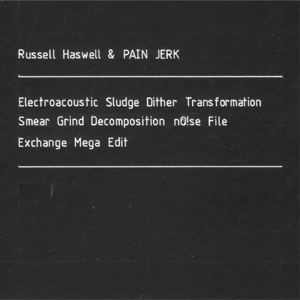Russell Haswell & Pain Jerk, "Electroacoustic Sludge Dither Transformation Smear Grind Decomposition nO!se File Exchange Mega Edit"
 A collaboration between these two artists makes perfect sense, given how both have carved out their individual niches working with rhythmic sounds in non-traditionally rhythmic situations. Russell Haswell has worked overtly in both realms, and his recent work with power electronics legends Consumer Electronics has him going as far as conventional techno beats. Pain Jerk's Kohei Gomi, on the other hand, has worked mostly as a harsh noise artist, but one of the few that has shaped harsh noise outbursts into ersatz rhythms. Split into two discs (one edited by Haswell, the other by Gomi), this is a sprawling, brilliant mass of sound culled from solo recordings and live performances that stand out strongly amongst both their other work.
A collaboration between these two artists makes perfect sense, given how both have carved out their individual niches working with rhythmic sounds in non-traditionally rhythmic situations. Russell Haswell has worked overtly in both realms, and his recent work with power electronics legends Consumer Electronics has him going as far as conventional techno beats. Pain Jerk's Kohei Gomi, on the other hand, has worked mostly as a harsh noise artist, but one of the few that has shaped harsh noise outbursts into ersatz rhythms. Split into two discs (one edited by Haswell, the other by Gomi), this is a sprawling, brilliant mass of sound culled from solo recordings and live performances that stand out strongly amongst both their other work.
Personally, I am more familiar with Gomi’s Pain Jerk output than I am with Haswell’s prior work.Pain Jerk always stood out as a unique project in the often crowded Japanese noise scene due to his penchant to not only work with hyper-speed edits and micro-cuts of sound, but to frequently get "stuck" (for lack of a better term) in short loops that made for excellent, memorable bits of clanging industrial rhythm before dissolving back into an unadulterated roar.This technique can be heard throughout both discs, but he does not overly rely on it, even on his own disc.
Of the two, "Russell Haswell’s Mega Edit" is the most varied and diverse, which is important since his is over twice the length of Gomi's (73 minutes versus 35).Here the electroacoustic part of the wordy title of the set are the most fitting, with filtered radio static and tonal swells that nod back to the earlier days of experimental electronic music showing up frequently in its early moments.Different passages seem sourced from the high brow world of modular synthesis, then back to the dirtiness of guitar pedals. Some archetypical Pain Jerk junk loops appear, but with a different laptop DSP sheen to them.
A junky drum machine does appear about half way in, making for the only traditional rhythmic accompaniment on here, but buried under harsh expanses of squeal and distortion to work as a perfect symbol of Haswell’s two extremes.At times it even drifts into some Autechre like pseudo-generative rhythmic synthesis before just coming apart in sheets of pure noise and overdrive.
On the other disc, "Pain Jerk’s Mega Edit" begins with probably the most peaceful moments of both discs, with filtered static and processed feedback smoothing out most of the most abrasive elements of a noise recording into an almost calming ambient expanse.This is short lived, as I had expected (and hoped), because soon it just becomes a paired ultra high and low frequency blast, like the world’s most annoying hearing test left on for way too long.
From here, things slip more into Gomi’s comfort zone, emphasizing the harsh noise moments versus Haswell’s occasional nod to academic electro-acoustic sound.He relies less on his looping as a form of rhythm and more as a texture, such as the extended, frozen moment towards the middle that, sustained for as long as it is, seems to slip into some sort of melodic mood (but might just be my brain pretending that it is).Regardless of that, he chooses to end the mix on his standard blown out noise style, resulting in an appropriate harsh climax.
Gomi and Haswell had been in touch for some 15 years before actually collaborating live in 2012, which is where the source material for these mixes originated.In performance, the two were using solo material both had exchanged for years prior as their source, so this set is a convoluted bit of solo material-live collaboration-solo edits.Given how strong both discs are, and how distinctive each of them make their respective mixes sound, I would say that the collaboration is a definite success.
samples:
 



